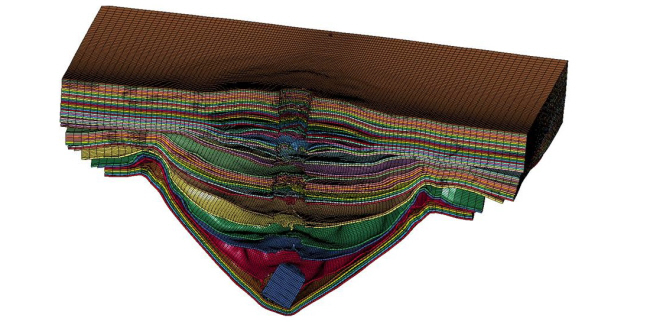Mark Hazzard (2012 cohort)
 Please provide a brief summary of your PhD project.
Please provide a brief summary of your PhD project.
I investigated thermoplastic composites used in high speed impact. The aim was to maximise the perforation threshold, whilst minimising the back face signature for a given areal density.

The image shows a finite element model of a ballistic impact on a Dyneema® composite showing partial perforation of the laminate.
Did you choose to continue your XP project as a PhD? Why or why not?
I chose to do something out of my comfort zone for my XP to learn something new. I had a really enjoyable experience collaborating with the Department of Chemistry, however I would say the lack of intuition within the field led me back to do my PhD with a greater focus in the engineering domain.
How did the taught component benefit your PhD research?
It gave a broader understanding of materials science. In any research project now I feel I have a good baseline knowledge, prior to getting into the finer details of a problem.
How did the cohort structure benefit your PhD research?
Having the cohort allowed us to learn from one another, whilst also providing a good sociable atmosphere to work in.
What did you most value about being part of a CDT?
That extra support from the first year of study, your peers, as well as additional training that is available.
What was the 'impact' of your research?
The model produced provided insight into the driving material properties for high speed impact. This provides feedback to the materials design, where the process of the next generation of these materials can begin.
What was your destination on leaving the CDT?
Research Scientist at Royal DSM, a materials supplier from the PhD project.
What are your main responsibilities?
Following on from the PhD, I use the same models to help gain understanding of material performance. I am also involved in other projects within the company, providing much more opportunity to further my knowledge regarding polymer mechanics.
Where do you see yourself in five to ten years' time?
I hope I can progress to become a senior scientist. Working for a company provides the enjoyment of helping to implement research and see the value of new and improved materials being used.
How have the skills and knowledge you acquired during your time in the CDT helped develop your career?
Technical skills both in the lab and with use of finite element analysis has been a real help. The opportunity to attend and present at international conferences was also a real bonus, growing personal networks and getting involved with the academic community.
Anything else you want to mention?
I don't think there are many places in the world that can provide the opportunity to perform research in such a wide range of areas all relating to composite materials. The large group of talented students and academics in ACCIS provides the chance to gain a breadth of knowledge not only from teaching but also by providing the chance to learn from others. I would like to thank fellow researchers and staff as the passion and enthusiasm for research in the area of composite materials made ACCIS an enjoyable place to work.